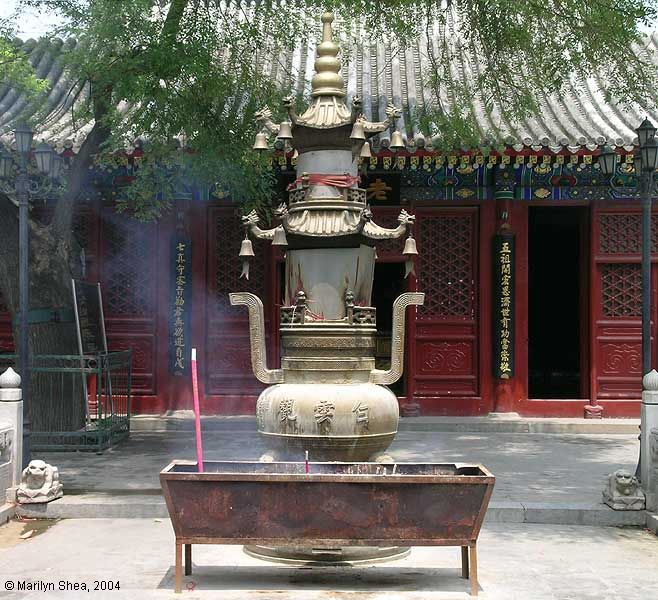 |
|
Incense burners outside Lao Lü Temple 老律堂. Incense is burnt to drive away evil spirits and as a prayer to heaven. The smoke carries the prayers.
Wang Chongyang wrote extensively. He expressed many of his ideas in poetry and encouraged the form in his followers. He wrote essays and longer tracts that have become part of the Daoist canon, or teachings. A very superficial idea of the teachings of Wang Chongyang and Complete Perfection Daoism can be gotten from reading the list of topics treated in his Fifteen Essays. Fifteen Essays by Wang Chongyang on the Establishment of the Complete Perfection Teaching
Taiji 太极拳 (Tàijí Quán) and Qigong 气功 (Qìgōng), as well as the martial arts, were physical disciplines encouraged by Wang Chongyang to achieve control over breathing and the body. Wang Chongyang sought to incorporate elements from Confucianism and Buddhism into a complete philosophy. He saw all philosophy as seeking the same thing, each having useful aids to man's quest for perfection. The Jin or Jurchen Emperor 世宗 (Shìzōng, 1123 - 1189) invited one or two of Wang Chongyang's disciples, Wang Chuyi and perhaps Qiu Chuyi, to the palace to discuss and teach Daoism. Quanzhen teaching had become widespread and the next Jin or Jurchen Emperor Zhangzong 章宗 (Zhāngzōng, 1168 - 1208) banned it as a threat to the traditional order of things and to his rule. Eventually he, too, was converted. Quanzhen Daojia 全真道家 (Quánzhēn Dàojiā), the Complete Perfection tradition or sect of Daoism is only one of many traditions. Over the centuries it grew to be very influential and widespread. During the Cultural Revolution, it was almost totally wiped out as monasteries all over China were razed or burnt and the monks dispersed or jailed. Following the Cultural Revolution, the Chinese government reversed its policy and Baiyun Guan was repaired and refurbished, and other temples were rebuilt. Over the past fifteen years, the government has given increased support to Buddhist, Confucian, and Daoist teachings and religious practices to encourage moral development and philosophy. Karl Marx had said in his Introduction to A Contribution to the Critique of Hegel’s Philosophy of Right:
The focus of the Communist world was on religion as the opium of the people. Religion was viewed as the tool of the State to promise happiness in another life as a means to permit the exploitation and slavery of people in this life. Religions framed suffering at the hands of governments and landowners as something to be endured for the greater glory and for a higher place in heaven. Religions often served the ends of those who wished to justify tyrannical rule or subjugate others. American slavery was supported by Christian churches teaching the lesson of Job to promise the pearly gates to those who had no freedom or dignity on earth. Politically, religion was, and is seen, as a potential threat because it divides loyalties and offers a different interpretation of life and truth. But religion can be seen as a complement to a civil society, a guiding force of right and wrong. It is this aspect that served as the underpinning of the government's support and the resurgence of certain religious practices in China. |
http://hua.umf.maine.edu/China/beijing2.html
Last
update: October 2009
© Marilyn Shea, 2009